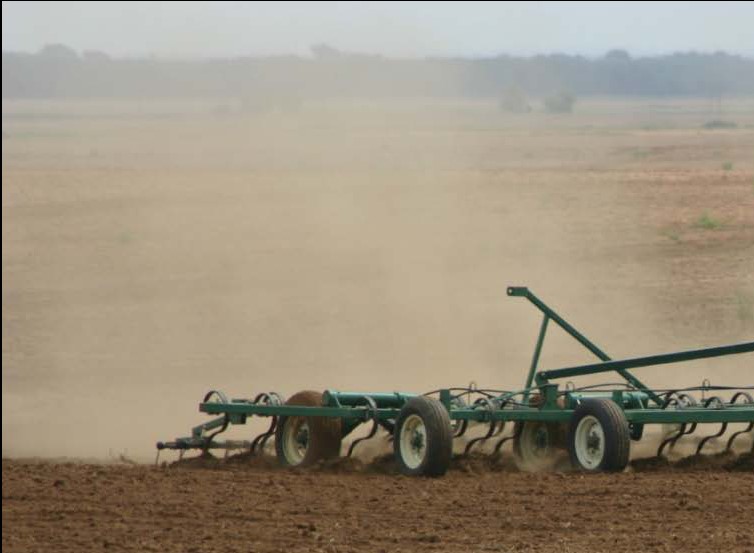
Agricultural News
Farmers Need to Delay Tillage on Failed Wheat Acres to Minimize Wind Erosion This Summer
Fri, 29 Apr 2011 6:59:38 CDT
 This year's drought conditions, particularly in western Oklahoma, raises concerns about the potential for wind erosion to become a significant problem in the near future. Wind erosion is always a concern in western Oklahoma, and in the past 25 years efforts to reduce wind erosion have been successful. In fact, during this period erosion by wind has been reduced by 40% on average across the State.
This year's drought conditions, particularly in western Oklahoma, raises concerns about the potential for wind erosion to become a significant problem in the near future. Wind erosion is always a concern in western Oklahoma, and in the past 25 years efforts to reduce wind erosion have been successful. In fact, during this period erosion by wind has been reduced by 40% on average across the State.
Despite this success, this year presents circumstances that raise concern. First, the drought has caused a potential for tillage to be initiated earlier in the fallow period, following either a failed grain crop or the removal of stocker cattle due to limited forage production. Early tillage is concerning because May and June are much windier than the regular fallow period between July and October. Also, simply increasing the period of time during which the ground is bare increases the amount of soil that can be lost to wind erosion.
In addition to minimizing wind erosion, eliminating or at least delaying tillage during your summer fallow period provides the benefit of conserving valuable soil moisture. If the forecasts are correct, it will be important to conserve as much of the rainfall received this summer as possible.
Maintaining residue on the soil surface will minimize evaporation of soil moisture. This will aid in recharging depleted subsoil moisture. A study at Lahoma, OK where soil moisture is monitored in no-till and conventionally-tilled wheat (Figure 1) shows that more than 1 inch of water is lost from the surface 15 inches of cultivated soil after the initial tillage event. Additionally, the data shows that after each subsequent rainfall event sufficient to saturate the soil surface (>2inches), evaporative water loss caused the tilled treatment to contain 1 inch less water than the no-till treatment. Therefore, the surface soil was always drier under tilled conditions, except for directly after a significant rainfall event (>2 inches).
Under this year’s conditions this means that cultivated cropland will require more water to recharge the depleted subsoil because the rainfall will have to be sufficient to first saturate the surface before draining down to the subsoil. Another good reason to delay, if not eliminate, tillage from this year’s fallow period is the current cost of fuel combined with generally inexpensive herbicide options. I would encourage you to check with your local dealer and do a price comparison between your planned tillage operation and the cost of a burndown weed control option such as glyphosate. This is a good idea even if your soil is not susceptible to wind erosion. In fact, since May and June are generally our wettest months, the use of herbicides instead of tillage for weed control will reduce water erosion by maintaining that surface residue. Furthermore, tillage may not completely control weeds that have developed large root systems during the fall and spring. Unless these weeds are adequately buried or killed with tillage, they may re-root and continue growing after a rainfall event. In these situations, herbicides such as glyphosate will provide the most effective control and prevent the weeds from maturing.
Delayed tillage management practices can also be applied to those fields where stocker cattle have been removed. Compaction is of course always a concern when grazing cattle, particularly in a grazeout situation. Therefore, many producers are tempted to begin tillage shortly after cattle are removed to improve infiltration. However, as long as a field has not been grazed to bare ground, tillage does not generally have a positive effect on the capture and storage of rainfall. Additionally, because rainfall was limited if not nonexistent this spring compaction should be minimal anyway. Remember that compaction is most severe when cattle graze on moist soils. Therefore, delaying tillage is a good idea from a moisture and erosion control point of view for grazed fields. Only where grazing has resulted in bare ground will tillage potentially provide benefit. In this scenario, which is generally avoided because cattle stop gaining weight before this occurs; there is no longer residue to protect the surface from crusting. This can cause the initiation of runoff during even small rainfall events and limit the capture of rainfall. If this has occurred or does occur on your farm during the next small rainfall event, shallow knife tillage may be ideal to open the soil surface and conserve what little residue you have.
Lastly, if you are planning to plant a summer crop in fields were wheat has been terminated the next time it rains, this will be a good year to utilize no-till or strip till practices. As illustrated in Figure 1 tillage promotes evaporative water loss and because spring recharge of subsoil moisture has been limited throughout most of the western two thirds of the State it is important that we do what we can to conserve soil moisture. Eliminating tillage will also protect your soils from the potential for wind erosion in the event that the long-term forecasts are correct and we are in fact dry throughout the summer.
WebReadyTM Powered by WireReady® NSI
Top Agricultural News
More Headlines...




















